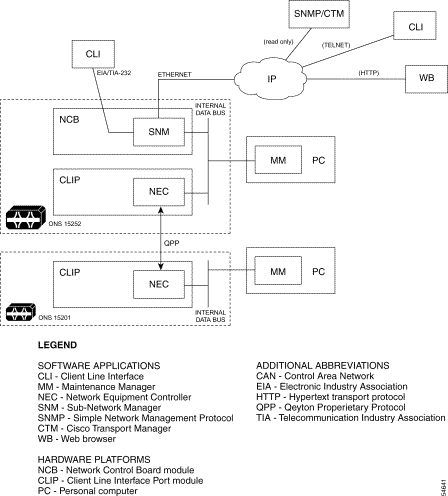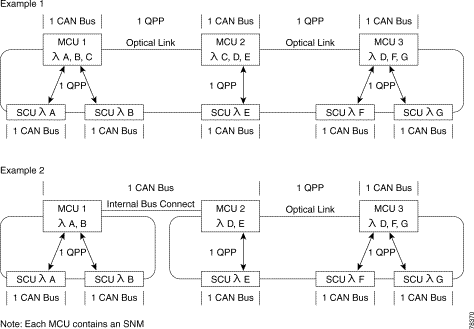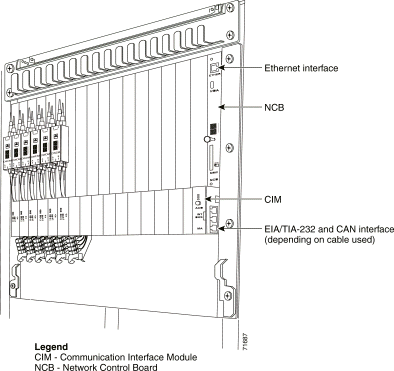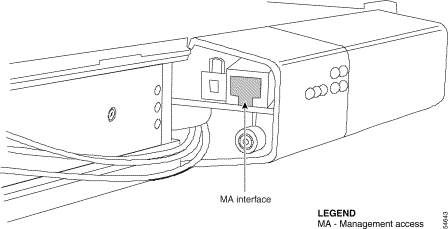|
|

This chapter describes the components required for operation, administration, and maintenance of the Cisco ONS 15200.
The NCB supervises, administers, and monitors the ONS 15200. In addition to controlling all of the ONS 15200 system CLIP modules, the NCB module collects information about system status, alarms, parameters, and actions on the internal data bus. See the "Alarms" section for a description of NCB alarms.
You can manage an ONS 15200 network using three different connection interfaces:
Figure 4-1 illustrates the three network management interface connections.

You can control the ONS 15200 system using the Subnetwork Manager (SNM) software package running on the NCB module located in the ONS 15252 MCU. Access the SNM through either the EIA/TIA-232 port or the Ethernet port on the front of the NCB module.
The SNM contains the CLI. The CLI is accessible via EIA/TIA-232 or Ethernet and is described in the "Command-Line Interface" section. It also contains the web-based interface. The web-based interface is accessible via Ethernet through the Internet and is described in the "Web-Based Interface" section. In addition, you can use Simple Network Management Protocol (SNMP) and the Cisco Transport Manager (CTM) to have read-only access to the ONS 15200.
The MM software package runs on a PC and accesses an MCU or an SCU via the controller area network (CAN) interface. It is described in the "Maintenance Manager" section.
An internal data bus, also called a CAN bus, connects an NCB module to different CLIP modules of the ONS 15252 MCU. You can extend this data bus over several collocated network elements (ONS 15252 MCUs, ONS 15201 SCUs or ONS 15216 modules) to a larger logical unit. The ONS 15201 SCU uses the same data bus as the MCU. Normally one CAN bus connects all ONS 15200 equipment located at one site.
An overhead channel is implemented as a base band modulation on the individual DWDM optical channels. Two end-points of a channel communicate using this low frequency signal, called QPP. The QPP specification defines the physical and link layer protocols for communication.
Any CLIP module controlled by an NCB must not be more than two QPP hops away from that NCB. If the CLIP is further away from the NCB, you must install additional NCB modules.
ONS 15200 Release 1.1 and later allows you to configure up to two active NCBs as managers of any CLIP in a network. To manage the CLIP, it must be no further than two CAN and two QPP hops away from the NCB. Any NCB in a network that is not provisioned as an active manager of a CLIP can still inventory the CLIP. Figure 4-2illustrates QPP hops with a CAN connection.

The EIA/TIA-232 port, located at the ONS 15252 MCU management access (MA) interface connector on the CIM, provides access to the SNM software running on the NCB module.
You only need the EIA/TIA-232 interface when you are setting the initial IP address of the NCB module. Two pins of the MA interface host the EIA/TIA-232 port; therefore, access the EIA/TIA-232 using the EIA/TIA-232 cable that is included with the ONS 15252 MCU. After you have set the IP address, you can communicate with the NCB module through the Ethernet port located on the front of the NCB.
Figure 4-3 illustrates EIA/TIA-232 interface access and Ethernet access to the ONS 15252 MCU.
After you have assigned an IP address to the NCB module, you can also send information to the NCB module by file FTP. Set the EIA/TIA-232 interface to the parameters listed in Table 4-1. Set the terminal settings to ASCII (send line end with line feed).
| Parameter | Value |
|---|---|
Speed | 19.2 Kbps |
Data Bits | 8 |
Parity | None |
Stop Bits | 1 |
Flow Control | None |

The SNM software package CLI is a simple, interactive tool that manages the ONS 15200 system.
The CLI resides on the NCB module and operates on the database server for the ONS 15200 system. The CLI interface has two modes of access for users—read-and-write access and read-only access. Users are separated into three categories: administrator, operator, and guest. Each category has different privileges:
To access the CLI, use the Ethernet port on the NCB module or the MA interface on the CIM module. The MA interface access requires an EIA/TIA-232 cable.
In addition to the required cabling, a laptop must have a CAN Personal Computer Memory Card International Association (PCMCIA) board to use the MM software package as a local craft interface.
Connect your MM-equipped computer to the ONS 15200 system through the MA port as shown in the following figures. Figure 4-3 shows the management access connection to an ONS 15252 MCU. Figure 4-4 shows the management access connection to an ONS 15201 SCU.

To get read-and-write access to the ONS 15200 system data from any valid IP address, the NCB module must have a defined IP address and you must log into the SNM software from the web interface. That is necessary to get access to the management functions of the web interface.
 |
Note The preferred web-based interfaces are Internet Explorer 5.5 or 6.0, Netscape Communicator 4.7, or Opera. |
The CAN bus is a serial communications protocol interface bus that allows you to connect several ONS 15200 systems to create a more powerful network element. The CAN bus supports distributed real-time, secure control. Figure 4-5 shows the two data bus extension ports on the ONS 15252 MCU. Figure 4-6 shows the two data bus extension ports located on the ONS 15201 SCU.


The Cisco Transport Manager (CTM) allows read-only access to the ONS 15200 system data. CTM Release 3.0.1 supports SNM 1.0(5), 1.1(1) and 1.1(2) of the ONS 15200.
In the ONS 15200 web-based interface, the Alarms screen shows all the active alarms recorded for each module installed in the network. Table 4-2 describes the CLIP module alarms, Table 4-3 describes alarm status parameters, and Table 4-4 defines the on-screen colors displayed next to the alarm status.
| Condition Name | Definition |
|---|---|
DWDM_RXPOWER (unprotected only) | The power input from the A-side of the ONS 15200 network is outside the acceptable power range. |
DWDM_ARXPOWER | The power input from the A-side of the ONS 15200 network is outside the acceptable power range. |
DWDM_BRXPOWER | The power input from the B-side of the ONS 15200 network is outside the acceptable power range. |
DWDM_PELTIERCURRENT | The Peltier current of the selected CLIP module is outside the acceptable range. |
DWDM_LASERTEMP | The temperature of the laser transmitting to the ONS 15200 network is outside the acceptable temperature range. |
CLIENT_RXPOWER | The power input from the client equipment is outside the acceptable power range. |
CLIENT_LASERTEMP | The temperature of the laser transmitting to the client equipment is outside the acceptable temperature range. |
ENVIRON_BOARDTEMP | The temperature on the surface of the CLIP module circuit board is outside the acceptable temperature range. |
| Alarm Name | Definition |
|---|---|
QPP (unprotected only) | Proprietary protocol error on the A-side of the network |
QPPA | Proprietary protocol error on the A-side of the network |
QPPB | Proprietary protocol error on the B-side of the network |
CAN | Error on the CAN bus |
POWER1 | PS-1 input is outside of the acceptable range |
POWER2 | PS-2 input is outside of the acceptable range |
FDI | Forward Defect Indication (alarm for remote side loss of signal) |
Equipment missing | Equipment configured but missing |
Datarate mismatch | Wrong data rate |
Loss of channel | Channel is missing |
DAC | D/A converter alarm |
FLASH | EEPROM alarm |
INSTRUCTION | Software attempted to write to an invalid location (autoclears after two seconds) |
STATUS | Alarm indicator |
| Alarm Name | Definition |
|---|---|
Red | Critical or major alarm |
Amber | Minor alarm or warning |
Green | Power on |
![]()
![]()
![]()
![]()
![]()
![]()
![]()
![]()
Posted: Mon Sep 30 23:14:34 PDT 2002
All contents are Copyright © 1992--2002 Cisco Systems, Inc. All rights reserved.
Important Notices and Privacy Statement.